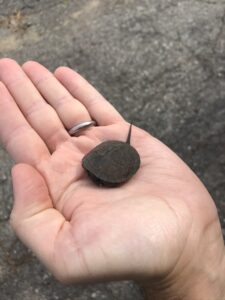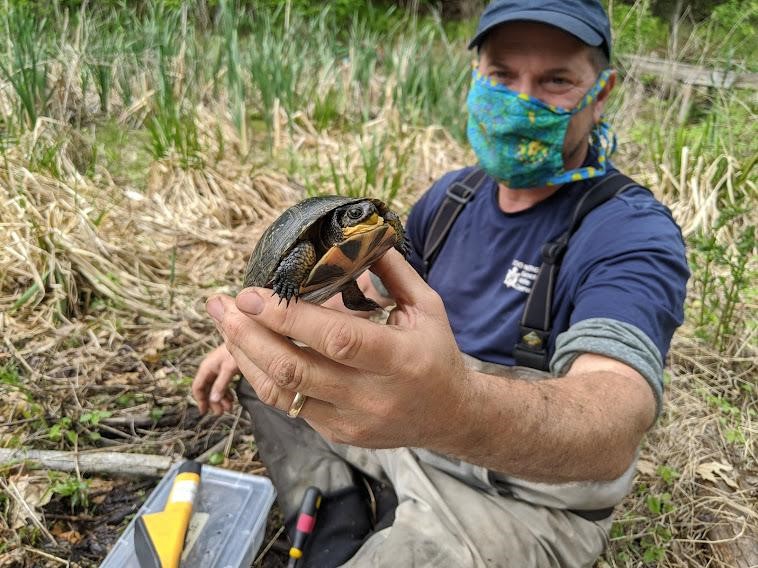Our Blanding’s turtle headstarting effort has been ZNE’s signature field conservation project for a long time. Have you ever wondered how and why this work got started? This week, we have a guest post from none other than Dr. Bryan Windmiller, the Director of Field Conservation and the man who started the program way back in 2003.
While working as a consultant, evaluating the impacts of proposed development projects on rare wildlife species, I had many wonderful opportunities to see and study rare salamanders and turtles, but I was saddened as their populations were diminished by the construction work that ultimately paid my salary. I was determined to find a way to push back against losing the local biodiversity that brought me so much joy.
A small consulting contract in 2003 allowed me to begin a conservation effort focused on the Blanding’s Turtles (Emydoidea blandingii) that lived in Great Meadows National Wildlife Refuge, a short distance from my home. My colleagues and I soon determined that this regionally large population of a rare species had declined by more than half since an earlier study, 30 years prior. Our data revealed that adults had high annual survival rates, with many at least 50 or 60 years of age. There were, however, few individuals younger than 16-20 years old, the age at which females begin to nest. As older adults died, there were no youngsters to replace them.

We began searching for ways to boost the odds that young Blanding’s Turtles would survive to adulthood. By radiotracking adult females, we were able to protect about half of all nests each year from predation, likely more than doubling the number of turtles that hatched successfully. This alone, however, was insufficient; a study by Justin Congdon estimated the odds of a Blanding’s turtle surviving from hatching to adulthood at only 3%. We began collecting the hatchlings and raising them for nine months in captivity. In this “headstarting” process, the average hatchling increases its weight 15-fold, growing to the size of a wild three to five-year-old by release and would thus, we hoped, be better able to evade predation. MassWildlife had successfully pioneered this method with red-bellied cooters beginning in the 1980’s.

At first, we headstarted 10-20 hatchling turtles annually with partners at Zoo New England and the New England Aquarium. In 2009, with the blessing of USFWS and MassWildlife, I turned to local schools for help in raising the Blanding’s Turtle hatchlings in their classrooms. The idea proved popular and the number of participating schools grew quickly. We gave husbandry lessons and classroom presentations to each headstarting class and took the students out on field trips, the final one culminating in releasing the young turtles back into the wild. We then tracked the growth and survival of more than 100 headstarted individuals for up to six years post-release.
I began doing this work as an offshoot of the small ecological consulting company that I managed. But in 2013, I decided to go all-in and founded an NGO, Grassroots Wildlife Conservation, with a mission to restore declining populations of rare animals and plants in New England and involve local people in those efforts. By 2018, we had merged into Zoo New England, our long-time conservation partner, becoming the zoo’s new Field Conservation Department. With increased staff, we scaled up our field monitoring, headstarting efforts, and classroom programs and have, to date, released nearly 700 headstarted young Blanding’s Turtles at Great Meadows. Radiotracking and mark-recapture estimates indicate that our efforts have succeeded in more than quadrupling the Great Meadows Blanding’s turtle population since 2003. Although we’ve only protected and headstarted about half of all nests since 2004, more than 95% of all known juveniles in the population were headstarted. We now do similar projects with four rare turtle species at 12 different sites, also working with local partners to improve wetland and upland habitat to sustain the demographic gains.

We are proud of both the conservation successes that our projects have helped foster and that we engage about 2,500 students annually at 30 schools in learning about rare wildlife in their towns and directly helping in their conservation. The students learn that they can be agents of positive change, pushing back against the loss of local biodiversity. Our efforts, like similar ones undertaken by USFWS, MassWildlife, and other New England NGO’s, demonstrate that even long-term declines and local extirpations of rare species can often be reversed with sufficient knowledge and determination.
